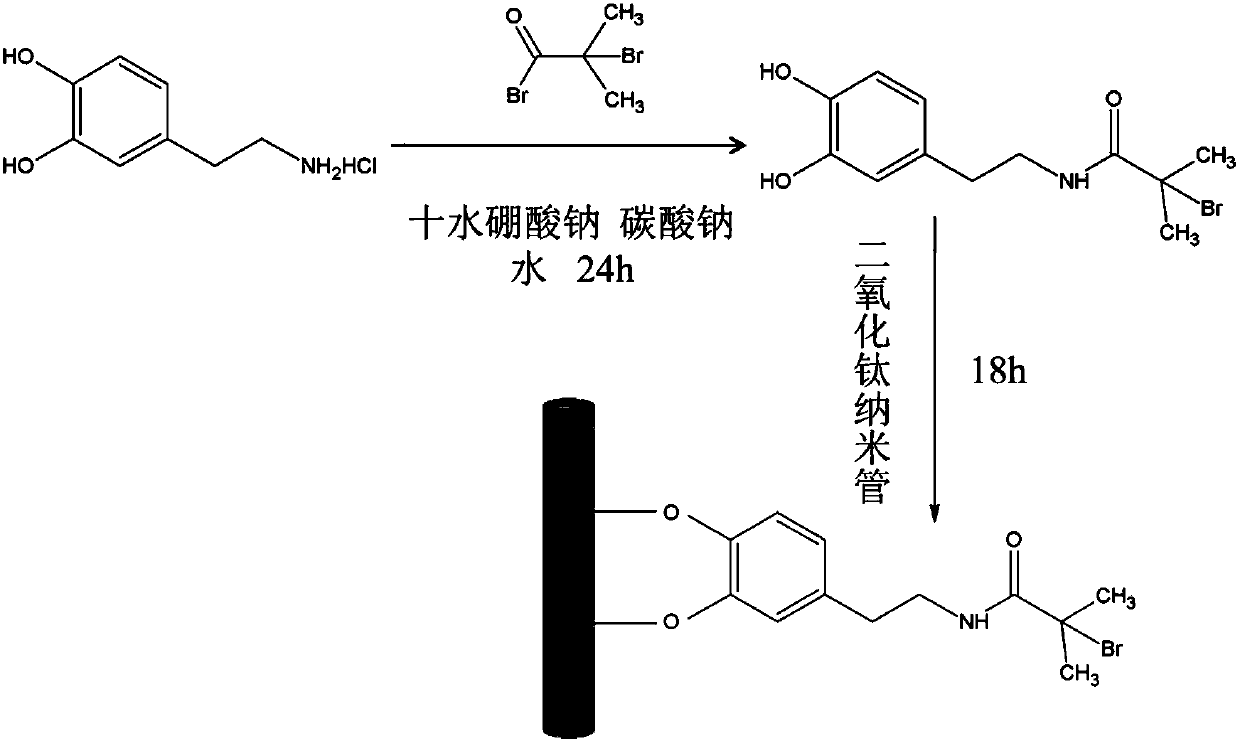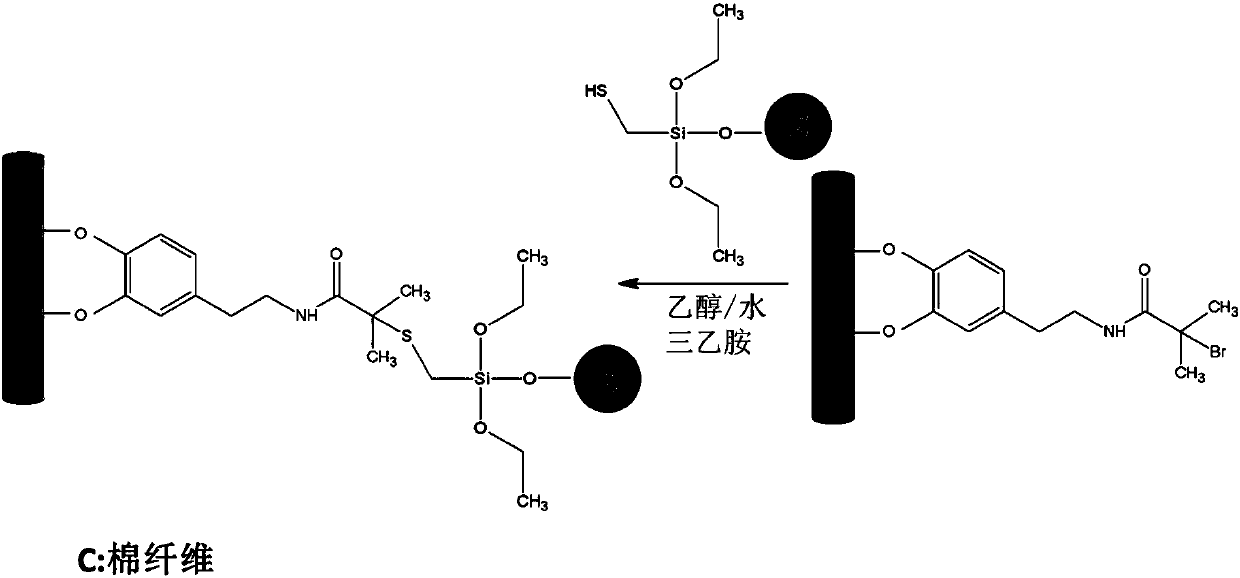Method for preparing titanium dioxide nanotube/cotton fabric photocatalytic material based on click chemistry
A technology of titanium dioxide and click chemistry, which is applied in chemical instruments and methods, water pollutants, plant fibers, etc., can solve the problems of easy aggregation of nano-titanium dioxide powder materials, difficulty in recycling nano-titanium dioxide, and reduced photocatalytic activity to achieve good photocatalytic activity. Catalytic effect, excellent environmental protection, high adsorption efficiency
- Summary
- Abstract
- Description
- Claims
- Application Information
AI Technical Summary
Problems solved by technology
Method used
Image
Examples
Embodiment 1
[0037](1) Dissolve 0.5g of sodium hydroxide and 0.7g of Pingpingjiao in 100ml of water to form a mixed solution, put 1g of cotton fabric (6cm×6cm) in the mixed solution, and ultrasonically clean it for 20min in a water bath at 70°C to remove the surface of the fabric Oil stains, get pretreated cotton fabrics.
[0038] (2) Dissolve 2g of silane coupling agent in 50ml of ethanol and water with a volume ratio of 4:1 to form a solution, adjust the pH of the solution to 3-4 with a boric acid solution with a pH of 2.0, and stir at 25°C for 30min , 0.98 g of the pretreated cotton fabric in step (1) was immersed in the solution for 2 minutes, and placed in a vacuum oven at 120° C. for 5 minutes to obtain a reduced cotton fabric.
[0039] (3) Add 4g sodium borate decahydrate and 100ml water into a 250mL three-necked flask to form a solution, and use N 2 Purge for 30 minutes, then add 1.9 g of dopamine hydrochloride, stir at a rate of 100 rpm for 15 minutes, and adjust the pH of the re...
Embodiment 2
[0043] (1) Dissolve 0.5g of sodium hydroxide and 0.7g of Pingpingjiao in 100ml of water to form a mixed solution, put 1g of cotton fabric (6cm×6cm) in the mixed solution, and ultrasonically clean it for 20min in a water bath at 70°C to remove the surface of the fabric Oil stains, get pretreated cotton fabrics.
[0044] (2) Dissolve 2g of silane coupling agent in 50ml of ethanol and water with a volume ratio of 4:1 to form a solution, adjust the pH of the solution to 3-4 with a boric acid solution with a pH of 2.0, and stir at 25°C for 30min , 0.98 g of the pretreated cotton fabric in step (1) was immersed in the solution for 2 minutes, and placed in a vacuum oven at 120° C. for 5 minutes to obtain a reduced cotton fabric.
[0045] (3) Add 4g sodium borate decahydrate and 100ml water into a 250mL three-necked flask to form a solution, and use N 2 Purge for 30 minutes, then add 1.9 g of dopamine hydrochloride, stir at a rate of 100 rpm for 15 minutes, and adjust the pH of the r...
Embodiment 3
[0049] (1) Dissolve 0.5g of sodium hydroxide and 0.7g of Pingpingjiao in 100ml of water to form a mixed solution, put 1g of cotton fabric (6cm×6cm) in the mixed solution, and ultrasonically clean it for 20min in a water bath at 70°C to remove the surface of the fabric Oil stains, get pretreated cotton fabrics.
[0050] (2) Dissolve 1.25g of silane coupling agent in 30ml of ethanol and water with a volume ratio of 4:1 to form a solution, adjust the pH of the solution to 3-4 with a boric acid solution with a pH of 2.0, and stir at 25°C After 30 minutes, 0.98 g of the pretreated cotton fabric in step (1) was immersed in the solution for 4 minutes, and placed in a vacuum oven at 120° C. for 5 minutes to obtain a reduced cotton fabric.
[0051] (3) Add 4g sodium borate decahydrate and 100ml water into a 250mL three-necked flask to form a solution, and use N 2 Purge for 30 minutes, then add 1.9 g of dopamine hydrochloride, stir at a rate of 100 rpm for 15 minutes, and adjust the pH...
PUM
 Login to View More
Login to View More Abstract
Description
Claims
Application Information
 Login to View More
Login to View More - R&D
- Intellectual Property
- Life Sciences
- Materials
- Tech Scout
- Unparalleled Data Quality
- Higher Quality Content
- 60% Fewer Hallucinations
Browse by: Latest US Patents, China's latest patents, Technical Efficacy Thesaurus, Application Domain, Technology Topic, Popular Technical Reports.
© 2025 PatSnap. All rights reserved.Legal|Privacy policy|Modern Slavery Act Transparency Statement|Sitemap|About US| Contact US: help@patsnap.com



